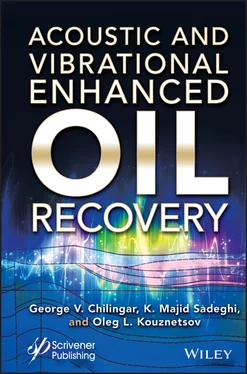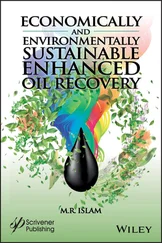1.1.5 Migration in a Gaseous Form
Kapelyushnikov (1954) [17], Gerber and Dvali (1961) [15], Zaks (1952 [40], 1955 [41]), Zhuze and Yushkevich (1959) [42], and Chilingar and Adamson (1964) [9] studied the possibility of oil migration in a gaseous form. Based on some experimental work, Chilingar and Adamson (1964) [9] concluded that some migration of petroleum could have occurred in a gaseous form in the geologic past at high temperatures.
It is important to remember that with increasing polarity of oil, the relative permeability to oil increases and that to water decreases (water cut decreases) (Sinnokrot and Chilingar, 1961 [32]).
Gerber and Dvali (1961) [15] subjected to extraction four samples of rocks with CO 2at pressures ranging from 100 to 400 kg/cm 2and temperatures of 40°C to 74°−90°C. Their findings can be summarized as follows:
1 The bitumens dispersed in rocks and, having composition related to crude oil, can dissolve in compressed gases and migrate together with them.
2 At 200 to 400 kg/cm2 pressure and temperature of 40°C, in dynamic conditions, CO2 can extract not only oils and tars but also asphaltenes and porphyrins from bituminous shales of Ukhta (Russia).
3 The kerosene and the main oil fraction of bitumens can be extracted from the rocks at pressures of 100 to 200 kg/cm2 and temperature of 40°C.
4 Mobile, syngenetic bitumens in the source rocks can dissolve just as easily in the compressed CO2 gas as does petroleum from oil-saturated rocks.
Kapelyushnikov (1954) [17], who studied the P-V-T relationship of oil, gas, and water at pressures up to 500 atmospheres and temperatures up to 100°C, concluded that gaseous oil/gas mixtures move toward the low-pressure areas, dropping the tars and asphaltenes first, followed by medium and lighter components. He also found that at critical pressures, the water and salts present in the oil-bearing strata are also transported together with the gas toward the low pressure areas.
1.2 Seismic Vibration Techniques
The use of various seismic vibration techniques in Russia resulted in incremental oil production of millions of tons. There are several seismic vibration techniques for transmitting energy into the reservoir, with oscillations over long distance. The area of productive reservoir around the well-being stimulated may be as great as 12 km 2. The number of wells simultaneously subjected to the treatment can range up to 50 (depending on the well spacing).
The technique for increasing the oil yield of high water cut and low oil production reservoirs consists of subjecting the reservoir area to cyclic low-frequency (5 to 90 HZ) elastic oscillations within the frequency range corresponding to the reservoir resonance (Kouznetsov et al. , 1998 [18]). The results obtained for during seven years of using this seismic vibration technique in different areas in Russia, on the average, annual oil production increased by more than 60%. The duration of the seismic vibration effect was 6 to 18 months and sometimes longer. The vertical reservoir sweep increased by 35%. In some cases, the wells that were producing by artificial lift (sucker rod pumps) retuned to natural flow with almost a tenfold rate increase. The effect was evaluated not only by an increase in the total production rate but also by a decrease in the waste cut. In some wells, the water cut decreased by 30% to 40% (Kouznetsov et al. , 1998 [18]; Simkin and Surguchev, 1991 [31]).
1.2.1 Producing Well Experiments
Field experiments were conducted using vibrators located at the Earth’s surface in the vicinity of oil-producing wells. Vibro-energy generated by vibrators traveled down as elastic waves to the oil-bearing formation. The goal of the experiments was to study the effect of elastic waves on the relative permeability to oil and to water, water saturation, oil production rate, and the rate of oil displacement by water. Generally, it was found that the presence of elastic waves increased the relative permeability to oil, decreased the relative permeability to water, the decreased the water cut, and enhanced the oil production. In terms of industry application, the use of vibroenergy for enhancement of oil recovery is acceptable only if the amount of generated vibro-energy is smaller than the amount of energy contained in the additionally recovered oil.
The authors studied the energy balance between the generated vibro-energy and energy contained in the additional oil produced by using vibrators. Calculations show that the amount of vibro-energy applied to one unit of rock volume does not exceed 1.5% of the energy contained in the oil present in this unit volume calculations were based on the fact that the energy content of 1 kg of oil is 4.2 = 107 J. Therefore, for this process to be economically feasible, it is necessary to increase the oil production by a minimum of 1.5% (Vahitov and Simkin, 1985 [36]). To study feasibility of enhanced oil recovery based on the use of vibro-energy, field experiments were conducted in several old oil field in Russia, Uzbekistan, and Kirgizstan.
1.2.2 Mechanisms of Interaction of Fluid Flow With the Vibro-Energy in Porous Media
Laboratory and field experiments demonstrate the dependence of fluid flow and character of oil displacement by water on application of vibro-energy. Results of experiments demonstrate that k ro/ k rwand the rate of water displacement by water increase on application of vibro-energy. The effect of vibro-energy on fluid flow the in porous media is defined by a number of nonlinear factors. Application of vibro-energy causes periodic or quasi-periodic movements of oil and water phases in pore channels with periodically changing directions. Due to these periodic movements, molecules of oil and water stick to a lesser degree to the solid phase. Accelerations of the oil phase and water phase are related to each other as (Kouznetsov and Simkin, 1994 [21]):
(1.5) 
where ρ oand ρ ware densities of oil and water, respectively; x oand x ware distances traveled by the oil droplet and water droplet, respectively; and t is the time.
Equation (1.5)shows that the acceleration of the oil phase, which has a lower density than water, will be larger than the acceleration of the water phase. The lower the density of oil, the higher will be the ratio of acceleration of oil to that of water due to applied vibro-energy. Thus, the time of possible static contact of oil molecules with a solid phase will decrease with decreasing density of oil. In turn, this will lead to a decrease of adhesion of oil molecules to the walls of the pore channels and better mobility of the oil phase. Mobility of the water will also increase, but to a lesser degree than that of the oil.
Periodic movements of the oil and water in pore throats and variable pressure gradient caused by the applied vibro-energy lead to the destruction of water films blocking fluid flow through narrow pore throats. This leads to a general increase of the relative permeability both to oil and to water. The molecules of oil are much larger than those of water. Therefore, destruction of water films sealing pore throats and increasing the size of the open part of pore throats should produce a larger effect on the relative permeability of rock to oil than that to water.
The relative permeability to oil also increases due to reduction in the interfacial tension and contact angle between oil and water on application of vibroenergy. As a result, the size of oil globules decreases.
Читать дальше













